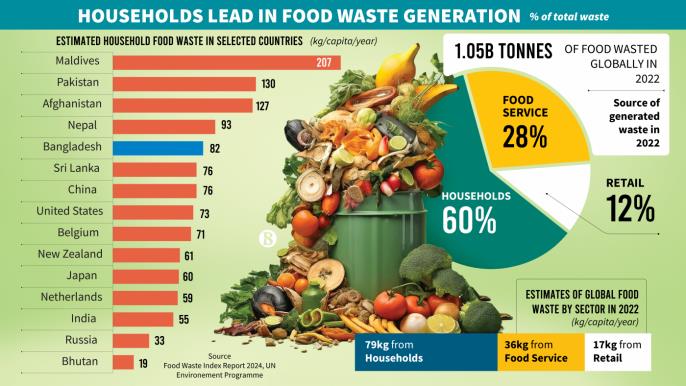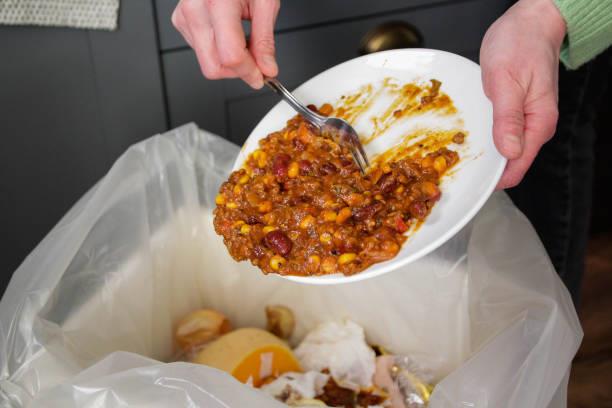
Food Wastage In Bangladesh Is Higher Than In Advanced Countries
Every year 14.10 million tonnes of food is wasted by households in Bangladesh, according to the“Food Waste Index Report 2024” published by the Nairobi-based United Nations Environment Programme (UNEP) 27 March.
The sorry state of food wastage has worsened compared to the previous estimate. According to the Food Waste Index Report 2021, Bangladeshis waste 65kg of food annually at home, resulting in a total of 10.62 million tonnes of household food waste in the country.
ADVERTISEMENTIn the report,“food waste” is defined as food and the associated inedible parts removed from the human food supply chain.“Food” is defined as any substance – whether processed, semi processed or raw – that is intended for human consumption.“Food” includes drink, and any substance that has been used in the manufacture, preparation or treatment of food.
Therefore, food waste includes both“edible parts” – the parts of food that were intended for human consumption, and“inedible parts” –
components associated with a food that are not intended to be consumed by humans. Examples of inedible parts associated with food could include bones, rinds and pits/stones.
Speaking to The Business Standard, agricultural economist and emeritus professor at Bangladesh Agricultural University, Dr MA Sattar Mandal said,“Food waste is an existing issue, and a paradox for a low-income country like Bangladesh. Several cultural factors may play a part, but one reason could be the increasing income and with that, people's habit of overspending and misusing.”
He added that,“There are about fourteen crore people living in rural areas and villages, and it is unlikely that the food waste occurs in those regions of the country. In fact, even during occasional programmes and celebrations, the unfinished food is distributed to the poor, and nothing is allowed to go to waste.”
He further added,“In other [more developed] countries, the issue of food waste is considered a public concern. In this regard, Bangladesh still has a lot to work on.”
As the latest report puts it, the amount of food wasted in some developed countries by a person in a home per year is 76kg in China, 71kg in Belgium, 61kg in New Zealand, and 33kg in Russia.
The 2024 study co-authored with WRAP, provides the most accurate global estimate on food waste at retail and consumer levels. It provides guidance for countries on improving data collection and suggests best practices in moving from measuring to reducing food waste.
The UN research estimates households across all continents wasted over 1 billion meals a day in 2022, while 783 million people were affected by hunger and a third of humanity faced food insecurity.
The report stated“In 2022 there were 1.05 billion tonnes of food waste generated (including inedible parts), amounting to 132 kilograms per capita and almost one-fifth of all food available to consumers. Out of the total food wasted in 2022, 60% happened at the household level, with food services responsible for 28% and retail 12%.”

Food wastage
F ood waste in South Asian homes
Bhutan households waste 19kg of food per person per year, which is the least among South Asian countries, followed by India (55kg), Sri Lanka (76kg) and Bangladesh.
The Maldives households waste 207kg of food per person per year, the highest in the region followed by Pakistan (130kg), Afghanistan (127kg) and Nepal (93kg).
“Food waste is a global tragedy. Millions will go hungry today as food is wasted across the world,” said Inger Andersen, executive director of UNEP.
He further added,“Not only is this a major development issue, but the impacts of such unnecessary waste are causing substantial costs to the climate and nature. The good news is we know if countries prioritise this issue, they can significantly reverse food loss and waste, reduce climate impacts and economic losses, and accelerate progress on global goals.”
The report said food waste is not just a“rich country” problem, with levels of household food waste differing in observed average levels for high-income, upper-middle, and lower-middle-income countries by just 7kg per capita.
At the same time, hotter countries appear to generate more food waste per capita in households, potentially due to higher consumption of fresh foods with substantial inedible parts and a lack of robust cold chains.
Global Issue
Food waste is a hugely important global issue. Estimates suggest that well over US$1 trillion worth of food is wasted each year (World Bank 2020). This represents more than one-third of all the food that is produced globally, using over a quarter (28 per cent) of the world's agricultural area (Food and Agriculture Organization of the United Nations [FAO] 2013).
This waste has devastating effects on both the planet and people. In 2022, an estimated 29.6 per cent of the global population was moderately or severely food insecure, and up to 783 million people were affected by hunger, around 122 million more than in 2019 (FAO 2023a). Reducing food waste can increase food availability for those who need it. Food waste also is responsible for an estimated 8–10 per cent of greenhouse gas emissions (FAO 2013). As environmental impacts accrue across the life cycle of food products, food waste at the consumer level presents the highest burden.
In 2021, the United Nations Environment Programme (UNEP) published the initial Food Waste Index Report, shedding new light on the magnitude of food waste and on the prevalence of household food waste on all continents, irrespective of country income levels.
END

Legal Disclaimer:
MENAFN provides the
information “as is” without warranty of any kind. We do not accept
any responsibility or liability for the accuracy, content, images,
videos, licenses, completeness, legality, or reliability of the information
contained in this article. If you have any complaints or copyright
issues related to this article, kindly contact the provider above.


















Comments
No comment